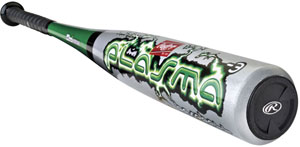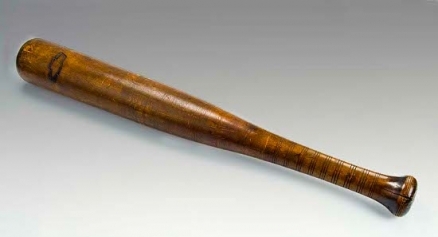Material use in baseball bats
| Topics: |
The first “official” baseball game was played in the early 1800s, more than 160 years ago. The equipment was simple: bat, ball, dirt playing field, and four wooden bases. No gloves.
In the early years, the players made their own bats, all from wood. Eventually, batmakers found that the best style of bat was long and slender, tapered, with a carved knob at the end of the bat for better control.
 Metal baseball bat. Source: NASA. Although the first metal bat was patented in 1924, players did not start using metal bats until the first aluminum bats were developed in the 1970s. Aluminum (of which the United States is one of the world’s leading producers) is derived from bauxite ore. Bats made of aluminum became an instant success. They were light, durable, and easy to use, and players could hit the ball much farther than with a wooden bat. Unlike the wooden bat, a metal bat temporarily flexes when hit with the ball, and springs back, transferring more energy to the ball than a rigid wooden bat. This so-called “trampoline effect” is the secret of the metal bat’s superior performance over a wooden bat.
Metal baseball bat. Source: NASA. Although the first metal bat was patented in 1924, players did not start using metal bats until the first aluminum bats were developed in the 1970s. Aluminum (of which the United States is one of the world’s leading producers) is derived from bauxite ore. Bats made of aluminum became an instant success. They were light, durable, and easy to use, and players could hit the ball much farther than with a wooden bat. Unlike the wooden bat, a metal bat temporarily flexes when hit with the ball, and springs back, transferring more energy to the ball than a rigid wooden bat. This so-called “trampoline effect” is the secret of the metal bat’s superior performance over a wooden bat.
Titanium bats were first introduced in 1993 but were later banned from official play because there were concerns that the bats were too dangerous. Various aluminum alloy bats were also introduced in the 1990s. The most successful of these was the scandium-aluminum bat. Scandium is a mineral that, when alloyed with aluminum, greatly increases the strength and resilience of the aluminum without adding to the weight. Scandium occurs in minute quantities in more than 800 minerals, and is usually obtained as a byproduct of refining uranium. Today, most high-quality metal bats are made from scandium-aluminum alloy.
The design of bats also continues to evolve as manufacturers search for ways to magnify the trampoline effect and increase the size of the bat’s “sweet spot” (the optimal place on the bat for hitting the ball). One design introduced in the late 1990s is a double-walled bat; this design comprises an outer wall of scandium-aluminum, an inner wall of a composite material (often graphite), and a “filling” of rubber or a thick fluid between the two walls. Another design structures the scandium-aluminum shell of the bat around a series of flexible arches.
Further Reading
| Disclaimer: This article is taken wholly from, or contains information that was originally published by, the U.S. Geological Survey. Topic editors and authors for the Encyclopedia of Earth may have edited its content or added new information. The use of information from the U.S. Geological Survey should not be construed as support for or endorsement by that organization for any new information added by EoE personnel, or for any editing of the original content. |
